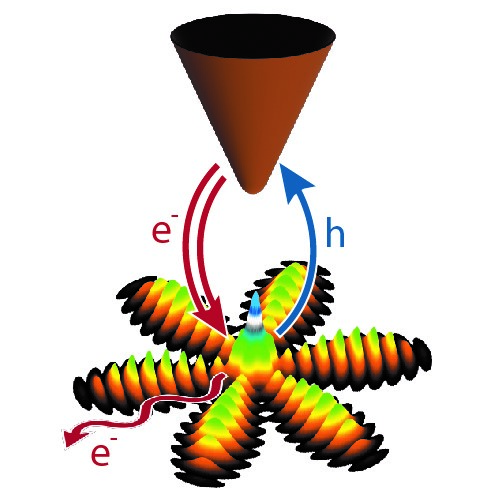Determining the intrinsic lifetime of states inside the superconducting gap generated by magnetic impurities (YSR states) is crucial for a better understanding of their properties and applications in quantum engineering. Unfortunately, since the intrinsic width of these states is typically much smaller than the energy resolution of standard scanning tunnelling microscopy, this has to date been challenging. Using atomic scale current noise measurements, researchers at the LPS have unveiled the exact details of transport through in-gap states in superconducting NbSe2, including their lifetime. In doing so, they managed to circumvent conventional limitations of the experimental energy resolution by two orders of magnitude.
Impurity states inside a superconducting gap are in principle perfectly isolated, since all electrons in the superconductor are paired up. The question therefore is how electrons flowing into a sub-gap state from the tip of a scanning tunnelling microscope move into the superconductor. One possibility is that a hole is reflected back into the tip (Figure), also known as Andreev reflection, creating a new Cooper pair. The alternative is that the electron somehow dissipates through inelastic processes, in other words that the state has a finite lifetime due to nonzero coupling with the superconductor.
Conventional measurements cannot easily distinguish Andreev reflection and inelastic relaxation, and the intrinsic lifetime is usually masked by a much larger thermal broadening. Using current noise measurements with a scanning tunneling microscope, researchers from the Laboratoire de Physique des Solides in Orsay resolved both problems. They show that a both processes operate simultaneously and from theoretical modeling of the data can directly extract the intrinsic lifetime of the in-gap states. This work has just been published in Physical Review Letters.

Figure. Noise measurements show that single electron tunnelling and Andreev reflection take place simultaneously for current flow into in-gap states. The magnitude of the noise is used to determine the intrinsic lifetime of the in-gap states.
Reference
Coherent and incoherent tunneling into Yu-Shiba-Rusinov states revealed by atomic scale shot-noise spectroscopy
U. Thupakula, V. Perrin, A. Palacio-Morales, L. Cario, M. Aprili, P. Simon and F. Massee
Phys. Rev. Lett. 128, 247001 (2022)
doi:10.1103/PhysRevLett.128.247001
Contact
Freek Massee
